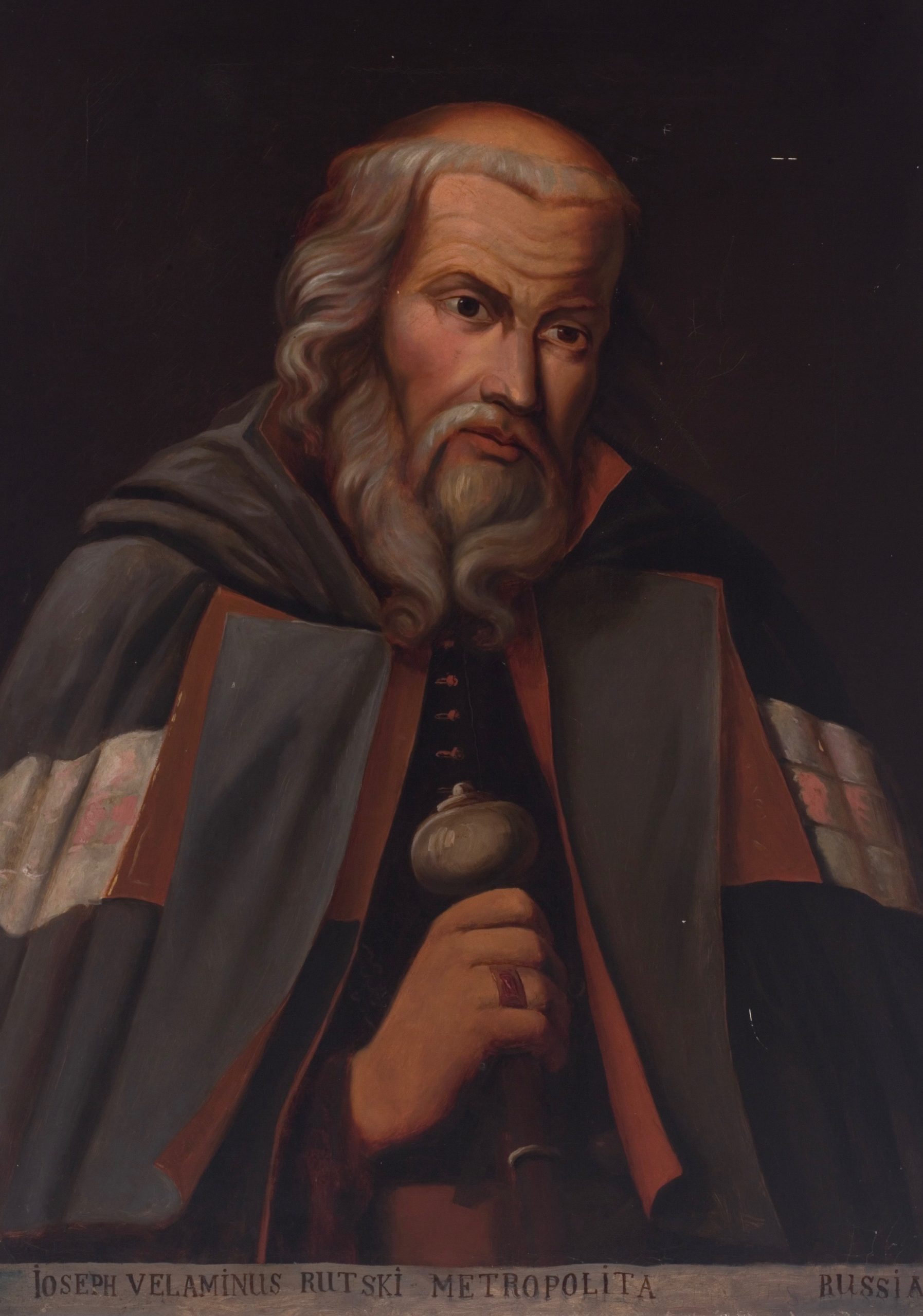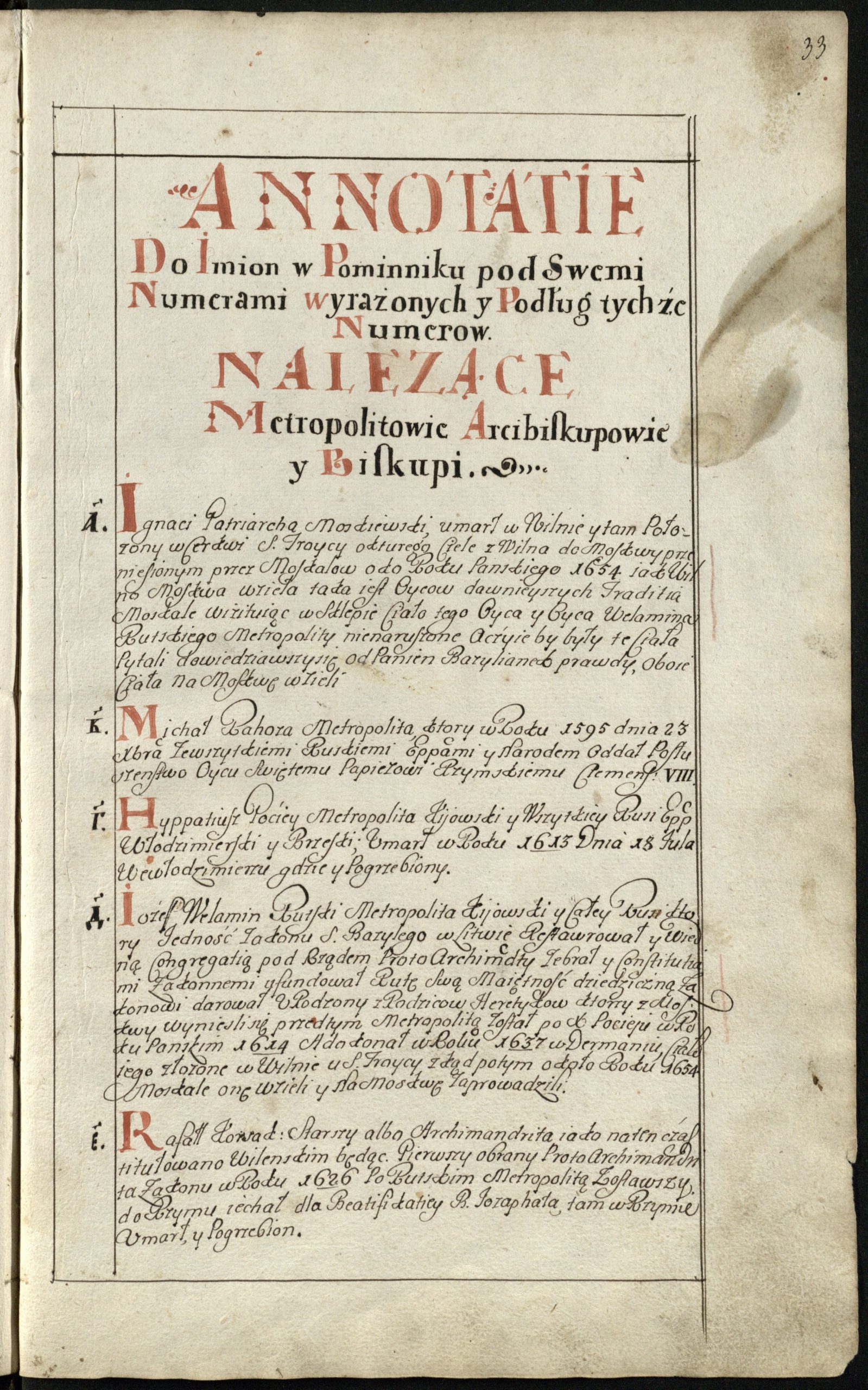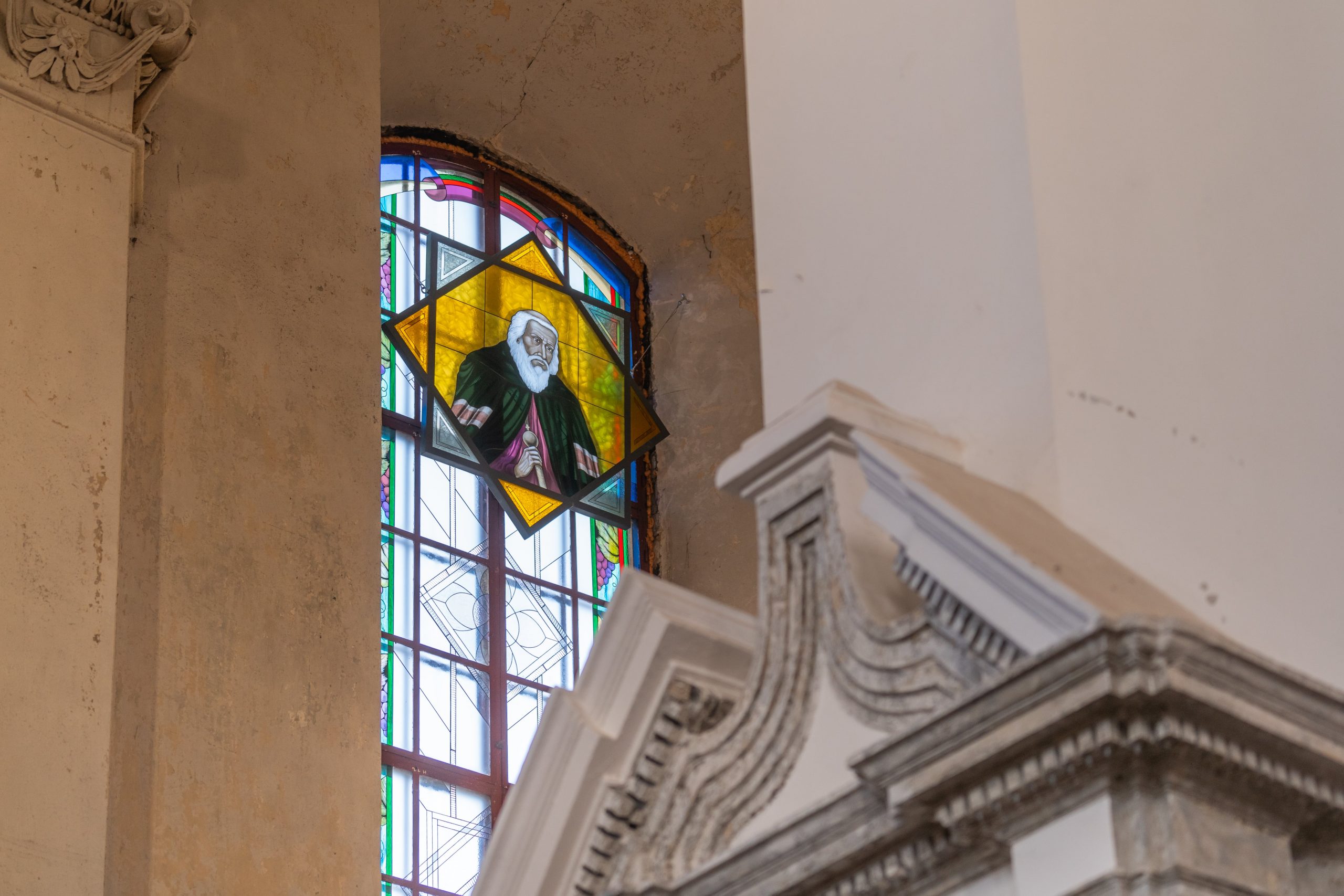Josyf Veliamyn Rutsky (secular name Ivan), who was born sometime between 1 April 1574 and 1 April 1575 in Ruta, and passed away on 5 February 1637 in Derman, Volhynia Region, was Uniate metropolitan from 1614 to 1637 [1].
The noble Veliamyns, of the Bukrav family crest, lived in the Novogrudok area, where their family nest was the Ruta estate. Gradually the Veliamyns started to call themselves “Rutsky” (“of Ruta”). It is possible that the family had Tatar roots. Denis Liseichikau, who discovered the metropolitan’s Ruthenian-language testament, considers that, through the mediation of Bishop Rafał Korsak, he himself caused the creation of the legend about the descent of the Rutskies from the Russian boyars Veliamyn. In this way he wanted to hide his Tatar roots, in order not to harm the reputation of the Uniate Church. The famous version inuhistoriography about the Russian background of the Rutskies has no convincing arguments now.1Денис Лисейчиков, “Завещание митрополита Иосифа Вельямина Рутского”, in: Завещания униатских иерархов Киевской митрополии XVII и XVIII вв. как пример религиозной культуры общества Речи Посполитой, ред. Анджей Гиль, Люблин: KUL, 2016, с. 47–73.
After studying at Calvinist schools in Novogrudok and Vilnius in the 1580s, Rutsky studied in Prague and Würzburg. Eventually he studied Rome, where in 1600 he entered the Pontifical Greek Catholic College and transferred to the Union. In 1601, he returned to the GDL and already in 1602 he was the head of the Uniate seminary in Vilnius. In 1605, he prepared a scholarly-pedagogical tract “Discourse”, in which he grounded the reform in the sphere of education and formation.2Mirosław Szegda, “Rutski Jan”, in: Polski Słownik Biograficzny, t. 33: Rudowski Jan–Rząśnicki Adolf, zesz. 137, red. Henryk Markiewicz, 1991–1992, Kraków–Wrocław: Polska Akademia Nauk, s. 256–260.
In Vilnius, he became acquainted with Josaphat Kuntsevych, a monk of Holy Spirit Monastery (↑). On 6 September 1607, Rutsky joined the local monastic community, and only a year later he was ordained a deacon. In 1608, he published his famous “Theses”, the particular theological doctrine of the Uniates in the area of scholarship on the holy sacraments (sacramentology).3Іван Саверчанка, Aurea mediocritas: Кніжна-пісьмовая культура Беларусі: Адраджэння і ранняе барока, Мінск: Тэхналогія, 1998, с. 234–236.
In July 1608, Metropolitan Hypatius Pociej (↑) designated Rutsky as his successor at Holy Trinity Monastery. After overcoming a conflict with the Orthodox in 1609, Holy Trinity Monastery was transformed into a spiritual center of the Uniate Church. In the time of Archimandrite Rutsky, the Vilnius Uniate monastery had up to 60 inhabitants.
Together with Holy Trinity Monastery, all the property of the Ruthenian Church in Vilnius was given to the jurisdiction of the Uniates. Rutsky carried out his duties fairly successfully, and in June 1611 Hypatius Pociej officially made him his auxiliary-coadjutor with right to succession. Pociej then ordained Rutsky as bishop and a year later passed the rule of the whole Kyivan Metropolitanate to him. On 5 April 1614, the Apostolic See confirmed Rutsky as head of the Uniate Church. In the fall of 1615, Metropolitan Rutsky visited His Holiness Pope Paul V in Rome, who raised him to the dignity of assistant to the papal throne.
Rutsky initiated changes in the Church, among which the most important was the Basilian reform of 1617, which foresaw the assimilation of the experience of post-Tridentine Latin Catholicism and also the preservation of the main elements of Eastern monasticism: liturgical traditions, asceticism, etc. Through the almost 25 years of his pastoral ministry on the metropolitan throne, Rutsky focused his main efforts on: raising the educational level and moral state of eparchial clergy; strengthening the Union in the GDL and Commonwealth; defending the rights and prerogatives of the Uniate Church; and searching for paths to understanding with the Orthodox, especially after the renewal of the Orthodox hierarchy in 1620–1621.4Pavlo Krečiunas, Vasilis Parasiukas, “Švč. Trejybės unitų vienuolynas ir Bazilijonų ordino steigimas”, in: Vadimas Adadurovas, et al., Kultūrų kryžkelė: Vilniaus Švč. Trejybės šventovė ir vienuolynas, moksl. red. Alfredas Bumblauskas, Salvijus Kulevičius, Ihoris Skočiliasas, Vilnius: Vilniaus universiteto leidykla, 2017, p. 80–91; same: Павло Кречун, Василь Парасюк, “Святотроїцький унійний монастир і реформа 1617 року”, in: Вадим Ададуров, et al., На перехресті культур. Монастир і храм Пресвятої Трійці у Вільнюсі (series: Київське християнство, т. 16), наук. ред. Альфредас Бумблаускас, Сальвіюс Кулявічюс, Ігор Скочиляс, Львів: Український католицький університет, 2019, с. 115–132.
The idea of a joint Kyivan Patriarchate was discussed by Rutsky and metropolitans Hiob Borecki and Peter Mogila. It was decided to call a joint unification council in Lviv in 1629, however the practical realization of the unification project did not happen. In the 1620s, the Smolensk Uniate eparchy, headed by Bishop Leon Kreuza, was created to strengthen the Union in the east.
At Rutsky’s initiative, in April 1621 the Orthodox community of Vilnius suffered a brutal pogrom. The “Vilnius tragedy” was made public. The sources illustrate the activeness and aggressiveness of Rutsky, who called Melecjusz Smotrycki to his tribunal and, without waiting, condemned him.5Леонід Тимошенко, Руська релігійна культура Вільна. Контекст доби. Осередки. Література та книжність (XVІ – перша третина XVII ст.), Дрогобич: Коло, 2020, с. 372–377. After the death of Josaphat Kuntsevych, Metropolitan Rutsky became initiator of the beatification of the martyr of Polotsk, emphasizing his heroic stand in defense of the unity of the Church.
In Rutsky’s written legacy, the polemical work “Sowita wina” (“double wine”), which came out anonymously in Vilnius in 1621, holds a special place. In this outstanding polemical work, the author enters into polemics with Melecjusz Smotrycki, the author of the work “Verification of Innocence”. At the end of the year, Rutsky managed to publish a response in Vilnius, “Defense Exam” (↑).
The dispute of two talented intellectuals of the Ruthenian Church ocurred around many questions connected with the status of the Orthodox Church as a consequence of the renewal of its hierarchy. Historians of literature invariably admit Rutsky’s literary talent, which is revealed through a wealth of artistic techniques, imagery of language, poetic style, and a bold use of folk poetic symbols and Roman and Greek mythology.
Rutsky’s activity at Holy Trinity Monastery is well documented. In the conflict of 1608–1609, he helped the metropolitan expose the Orthodox “conspirators” who sought to expel the Uniates (↑). In 1603–1606, Rutsky became rector of Holy Trinity Seminary. With Rutsky as metropolitan, the head of Holy Trinity Monastery in 1612–1617 was Josaphat Kuntsevych, in 1617–1624 Leon Kreuza. Already as archimandrite Rutsky managed to build up the Holy Trinity Complex, improving the monks’ daily lives and introducing a strict monastic rule. Holy Trinity Church was accessible to the faithful. In the period when the first Basilian chapter was held in Novogrudok in 1617, the monastery was the largest monastic community of the Uniate Church, transformed into a true center of Ruthenian monasticism in the Grand Duchy of Lithuania.
Metropolitan Rutsky left a great legacy of letters. Some were written in Vilnius, which allows one to track his connections with the city in more detail. So, in the period from 1621 to 1626, from Vilnius the metropolitan sent Chancellor Lew Sapieha 12 letters. The dates of the letters not only show when he was in Vilnius but partially show his attitude toward events in Vilnius and give his reflections on the city.6Ibid., с. 345.
The superiors of Holy Trinity Monastery were exceptionally zealous and authoritative figures among the Uniates. The hierarchy of the Uniate Church and the Basilian Order were recruited from among them. It is worth noting the high educational level of the Uniate archimandrites of Holy Trinity.
Holy Trinity Monastery in the 17th century received a number of endowments, among which perhaps the most resonant was the family estate of Rutsky, Ruta, in Novogrudok voivodeship, which he bequeathed in 1613.
On 6 February 1637, Rutsky died in the monastery at Derman. His body was buried in Holy Trinity Church in Vilnius (↑). In 1655, when the Muscovite army occupied the city, his remains were taken to Russia. (Their further fate is still unknown.) It is indicative that, not long after Rutsky’s death, he began to be revered as blessed and the numerous pilgrimages made to his grave witness to this [2, 3].
Leonid Tymoshenko
Išnašos:
| 1. | ↑ | Денис Лисейчиков, “Завещание митрополита Иосифа Вельямина Рутского”, in: Завещания униатских иерархов Киевской митрополии XVII и XVIII вв. как пример религиозной культуры общества Речи Посполитой, ред. Анджей Гиль, Люблин: KUL, 2016, с. 47–73. |
|---|---|---|
| 2. | ↑ | Mirosław Szegda, “Rutski Jan”, in: Polski Słownik Biograficzny, t. 33: Rudowski Jan–Rząśnicki Adolf, zesz. 137, red. Henryk Markiewicz, 1991–1992, Kraków–Wrocław: Polska Akademia Nauk, s. 256–260. |
| 3. | ↑ | Іван Саверчанка, Aurea mediocritas: Кніжна-пісьмовая культура Беларусі: Адраджэння і ранняе барока, Мінск: Тэхналогія, 1998, с. 234–236. |
| 4. | ↑ | Pavlo Krečiunas, Vasilis Parasiukas, “Švč. Trejybės unitų vienuolynas ir Bazilijonų ordino steigimas”, in: Vadimas Adadurovas, et al., Kultūrų kryžkelė: Vilniaus Švč. Trejybės šventovė ir vienuolynas, moksl. red. Alfredas Bumblauskas, Salvijus Kulevičius, Ihoris Skočiliasas, Vilnius: Vilniaus universiteto leidykla, 2017, p. 80–91; same: Павло Кречун, Василь Парасюк, “Святотроїцький унійний монастир і реформа 1617 року”, in: Вадим Ададуров, et al., На перехресті культур. Монастир і храм Пресвятої Трійці у Вільнюсі (series: Київське християнство, т. 16), наук. ред. Альфредас Бумблаускас, Сальвіюс Кулявічюс, Ігор Скочиляс, Львів: Український католицький університет, 2019, с. 115–132. |
| 5. | ↑ | Леонід Тимошенко, Руська релігійна культура Вільна. Контекст доби. Осередки. Література та книжність (XVІ – перша третина XVII ст.), Дрогобич: Коло, 2020, с. 372–377. |
| 6. | ↑ | Ibid., с. 345. |
Sources of illustrations:
| 1. | Held in: LNDM, LNDM T 4158 (Available at: Lietuvos integrali muziejų informacinė sistema, www.limis.lt/greita-paieska/perziura/-/exhibit/preview/20000001617243?s_id=MfY0X5DJITrVb9li&s_ind=3&valuable_type=EKSPONATAS, accessed: 2021 12 01). |
| 2. | Held in: LMAVB, Rankraščių skyrius, f. 19, b. 91, l. 33. |
| 3. | Photographer Edgaras Kurauskas, 2021. Collection of VU IF. |





